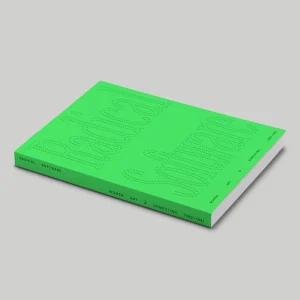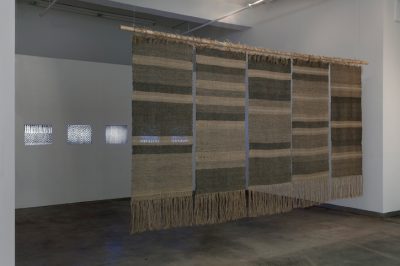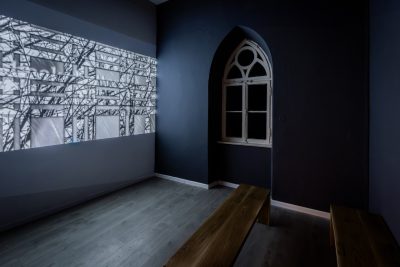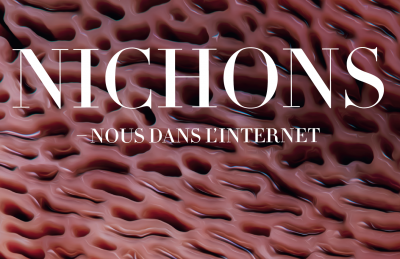bitforms gallery is pleased to announce A Coded Language, Beryl Korot’s second solo exhibition with the gallery. It features paintings on traditional and handwoven canvas, video, and drawings with ink and thread, highlighting the breadth of the artist’s practice across multiple media forms from 1980 to 2017. The works on canvas represent a period of her work in the 1980’s which is virtually unknown and are shown for the first time together in this exhibition.
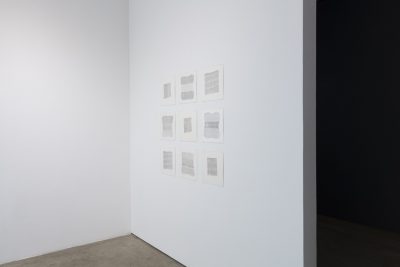
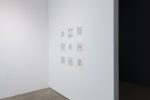
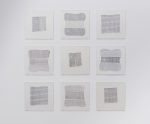
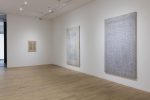
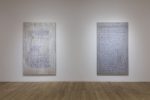
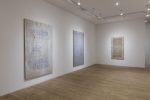
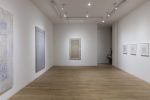
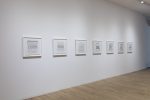
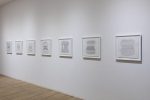
Opening: Thursday April 12, 6 – 8 PM
Gallery Hours: Wednesday – Saturday, 11 AM – 6 PM & Sunday 12 – 6 PM
bitforms gallery is pleased to announce A Coded Language, Beryl Korot’s second solo exhibition with the gallery. It features paintings on traditional and handwoven canvas, video, and drawings with ink and thread, highlighting the breadth of the artist’s practice across multiple media forms from 1980 to 2017. The works on canvas represent a period of her work in the 1980’s which is virtually unknown and are shown for the first time together in this exhibition.
In 1980, several years after completing her seminal multichannel video and textile installation, Text and Commentary, Korot began to weave her own linen canvases and invented a coded language based on the grid structure of woven cloth. Babel 1 (1980) and Babel 2 (1980) translate the Tower of Babel text from Genesis into this language. The Tower of Babel interested Korot because it is an ancient text about the impact of technology and language on human behavior and cultural change, issues she’d been concerned with as an editor of the video journal, Radical Software (1970-74). Years later, in 2006, she revisited her coded language in an animated video and print work titled Babel: the 7 minute scroll. Here the story is retold in several languages scrolling at different speeds: English, hieroglyphs, and Korot’s own.
In the paintings, Anordnung: Clearly Visible/Strongly Sewn (1985) and A=Girl (1986), Korot uses traditional canvas where the visible structure of the grid is less apparent and a more calligraphic gesture becomes a landscape for the human figure. A young girl from a photograph from the Holocaust appears silhouetted in these paintings. In Anordnung she appears as a patch, amidst both the landscape of Korot’s abstract language and the specific words, “one language one speech,” which refers to the first line of the Tower of Babel. In A=Girl, the silhouette appears as the letter “A” in L-A-N-G-U-A-G-E, spelled out at the top of the painting. These paintings are created from layers of oil paint, washed away in turpentine and embedded in the cloth to create a palimpsest of recorded time.
Etty (2009-2010) is a video inspired by the diaries of Etty Hillesum, a Dutch Jewish writer living in Amsterdam at the time of the Nazi invasion of Holland. To get messages to friends she devises her own code: book=butter, writing=jam, ink=rye bread, shoelaces=fruit. When she is finally transported to Auschwitz, she manages to throw a postcard from the box car with the words “we left the camp singing.” The slow, rhythmic falling of words against a background woven from moving video images, creates a new sense of reading and time. A soliloquy is created from short selections of Etty’s words edited from hundreds of pages of her writings.
Korot’s recent series of digitally embroidered drawings, Curves (2016-2017) refers back to Text and Commentary, which places ancient and contemporary technologies in dialog, tracing the origin of the computer to the loom. This exchange is continued through the exploration of the artist’s hand and that of the machine: here a sewing machine programmed to sew the surface of the paper in pre-designated areas. The texture, color, and shape of the sewn thread contextualizes and converses with the original hand-drawn marks.
Korot notes “Text (textus) and weave (texto) share the same latin root. Text is a tissue or fabric woven of many threads. It is a web, texture, structure, a thought, something that can be built, raveled and unraveled.”
Throughout her lifelong practice, Beryl Korot (born 1945) has brought the ancient and modern worlds of technology into conversation. An early figure in the history of video art, Korot was first known for her multiple channel video work in which she applied specific structures inherent to loom programming to the programming of multiple channels, constructing non-verbal narratives. Later, she invented a visual language based on the grid structure of handwoven canvas. Translating texts into her own language, she illuminated what thought might look like devoid of specific meaning. The sources for much of her work reach back to the technology of the ancient world, whether the technology of the loom or of writing itself. In her work, there is both the visualization of an interior landscape based on language and a spotlight on the intersection between technology and thought.
Co-founder and co-editor of Radical Software (1970-1974), the first publication to discuss the technical and formal possibilities of the new medium, Korot was also co-editor of Video Art: An Anthology, published in 1976. Her first multiple channel works—Dachau, 1974 (1974) and Text and Commentary (1976-1977)—have been exhibited at The Kitchen, New York, NY (1975); Leo Castelli Gallery, New York, NY (1977); Documenta 6, Kassel, Germany (1977); the Whitney Museum of American Art, New York, NY (1980, 2002); The Koln Kunstverein (1989), the Carnegie Museum of Art, Pittsburgh, PA (1990); the Aldrich Contemporary Art Museum, Ridgefield, CT (2010); bitforms gallery, New York, NY (2012); the Whitworth Gallery, Manchester, England (2013); Museum Abteiberg, Mönchengladbach, Germany (2013); Art Basel, Basel, Switzerland (2014); the Institute of Contemporary Art, Boston, MA (2014); Tate Modern, London, England (2014); the Wexner Center for the Arts, Columbus, OH (2015); and SFMOMA, San Francisco, CA (forthcoming, 2016).
Other video installations and works have been exhibited at the Hood Museum, Dartmouth College, NH; Locks Gallery, Philadelphia, PA; Garage Museum of Contemporary Art, Moscow, Russia; and Historisches Museum, Frankfurt, Germany, among many others. Two collaborations with composer Steve Reich—The Cave (1993) and Three Tales (2002)—brought video installation art into a theatrical context and toured worldwide. Both works continue to be performed and were exhibited as video installations at venues including the Whitney Museum; the Carnegie Museum; the Reina Sofía in Madrid, the Kunstverein in Düsseldorf, Germany; and ZKM in Karlsruhe, Germany.
Korot’s work is in both private and public collections. Text and Commentary was acquired by the Museum of Modern Art, New York in 2015 and Dachau 1974 is in the Kramlich Collection’s New Art Trust, shared by SFMOMA, MoMA, and Tate Modern, and is in the Thoma Foundation art collection. A Guggenheim Fellow (1994), Korot is the recipient of numerous grants including The National Endowment for the Arts and Anonymous Was a Woman (2008). In 2000, she was a Montgomery Fellow at Dartmouth College with Steve Reich and in 2011 she was an Artist in Residence at Dartmouth College.
Additional Information
Paintings
In 1980, several years after I finished making Text and Commentary (1976-1977), I began to weave my own linen canvases and invented a coded language based on the grid structure of woven cloth.
Interested as ever in the relationship of the ancient to the new, I sought a text that would engage that interest and found it in the Tower of Babel from Genesis, an early story about technology. The world of Babel in Mesopotamia (approximately 3000 BC) refers to a period of time when, as a species, we were moving from a herding society to one more agricultural and urban. It was a world impacted by the technology bitumen, used as mortar between fired bricks, as society transitioned from a God centered world to a human centered one. The unity expressed in the first line of its text, “and the whole earth was of one language and of one speech,” is displaced at the end of the story by a scattered race of humans who no longer understand one another. But commentaries suggest this is due to an internal defect, not that the richness of multiple languages should be the cause of misunderstanding. The abstract coded language itself can be contemplated as pure form as it reveals the universal shape of all language: small packets of information separated by spaces and placed in a linear manner, whether horizontal or vertical, a kind of language as still life.
The first two handwoven canvases (Babel 1 and Babel 2, made in 1980) simply translate the Babel story into my coded grid language, and language here can be contemplated as an abstract expression devoid of any particular meaning. As these canvases progress, the code is sometimes enlarged to contain images as in Let Us Make Bricks (1983) where silhouetted images reinterpret the story of Babel. Here, fleeing people coexist with the enlarged coded words “Let Us Make Bricks” that contain the image of train tracks.
In 1984, I stopped weaving my own canvases and switched to more traditional canvas where the visible structure of the grid as the basis for the language is less apparent and replaced by a more calligraphic gesture. For the paintings, Anordnung: Clearly Visible/Strongly Sewn (1985 and A=Girl (1986), the calligraphic language actually becomes a landscape for the human figure. Looking at photographs of the Holocaust, one in particular reaches out to me, so many could have. It is of a young girl, maybe 5 or 6 years of age, on the train tracks walking behind (what I assume is) her mother and younger siblings. She is looking down, slightly stooped and infinitely alone. I’m inclined to adopt her, to rescue her from oblivion, I think of her constantly and she appears, silhouetted, in three of the paintings. In Anordnung she appears as a patch amidst both the landscape of my abstract language and the specific words, ironic here, “one language one speech.” There are also pictographic images of smokestacks, and barely readable words of the order (anordnung) to wear the patch, as well as the eagle, the Nazi symbol of strength, courage, and immortality. Layers of oil paint are washed away in turpentine and become embedded in the canvas itself to create a kind of palimpsest of recorded time.
In A=Girl, the little girl on the train tracks is silhouetted amidst the abstract calligraphic language, and appears as the “A” letter in a frieze of figures at the top of the painting which spell L-A-N-G-U-A-G-E. The blue rectangle which appears in Babel 1 and Babel 2 as a substitute for the name of God in the text, is now orange, as in fire. This painting is also created from layers of erasures.
Many years later in 2006, I think again of the coded language and create a work called Babel: the 7 minute scroll. The code is the same as the one I used for the handwoven canvases but its realization is created and animated on the computer from right to left across the video screen for the duration of the 7 minutes. I also printed it on paper arranged it in 3 stacked strips each 12 feet wide by 2 feet high.
Three languages moving at different speeds retell the story: the phonetic roman alphabet in English, my coded grid language, enlarged, made of black squares in which interpretive drawings of Babel appear, and floating shadows of pictographic figures from ancient Egyptian wall drawings. As the work progresses images replace words.
Curves (2016-17)
In the late 60’s and early 70’s we talked about threading tape on a video tape recorder (VTR), the tape passing the erase head, wrapping around the head drum, passing the sound and control track head, and setting in between the pinch roller and capstan. If this wasn’t done correctly your image would not record and playback properly. The threaded tape itself was magnetic.
Until the present, threads (whether wool, linen, or magnetic tape) have been for me both metaphor and medium, and the technology that conveys them a clue to structure.
Curves (2016-2017) is a series of abstract drawings on paper, with ink, pencil and thread. As these works develop, threads are sewn on the surface of the paper with a digital sewing machine. The relationship between handmade and machine made are basic to this work. Instead of oil or water color, here the programmed loose structure of the threads allows the original drawn markings to be seen in a new way, and adds texture, color and depth to the surface of the work. The sewing machine is programmed to sew the surface of the paper in predesignated areas. The stitching itself (its shape and color, and whether it is open or closed to reveal the surface beneath) is another example of the impact of the computer on something as basic as the sewing machine.
Etty (2009-2010)
Etty Hillesum, a 29-year-old Dutch Jewish writer, lived in Amsterdam at the time of the Nazi invasion of Holland. In her diaries she documented the roundup and incarceration of Dutch Jews in the Westerbork transit camp until she was shipped out herself. She sought a place inside herself to resist the enemy while attempting to ease the suffering of those around her. To get messages to friends she devised her own code: book=butter, writing=jam, ink= rye bread, shoelaces=fruit. When her time for transport to Auschwitz finally arrived, she managed to throw a postcard from the box car she was in with the words “we left the camp singing.” A farmer in a field found the card and posted it to Amsterdam.
Through the very slow, rhythmic falling of words against a background woven from moving video images (wind storms, snow storms, fire), a new sense of reading and time is created. Each word has its own place and speed as it travels down the screen. In Etty (2009-2010), and in a companion work Florence (2008), a soliloquy is created from short selections of her words edited from hundreds of pages of her writings. We were collaborators of sorts.
— Beryl Korot, 2018
Text by Zabet Patterson
Beryl Korot, A Coded Language
What is necessary to code? What is necessary to language? For Beryl Korot, these questions stretch across multiple media forms: printed matter, video, the handloom, and drawing. In each, she returns to the line—as structure, as discipline, and as iterative process. We read printed matter line by line. Video builds an image “at 30 frames a second, line by line.” The loom articulates pattern, “thread by thread.” And drawing, for Korot, is a matter of precisely delineated, overlaid, and overlapping lines.
Korot was initially known for her work with Radical Software, a printed journal about video. The first issue opened with a questionnaire: a profound gesture of outreach that insisted this was a new kind of informational space, for a new kind of technology whose uses were thrillingly, radically undetermined.
Her groundbreaking early video work Dachau 1974 (1974) used the structure of weaving to bind and elaborate the lines of the television monitor. Ideas of warp and weft organized the progression and juxtaposition of images across four television monitors. Korot’s editing was an intensely embodied process—she was constantly spinning the tape spool forward and then rewinding to isolate small sections of time. These small sections repeat rhythmically.
Text and Commentary (1977), a second canonical work of early video art, gives us even more of a sense of the body of the artist. Five television screens show the process of weaving. We see hands tying strings, feet pressing treadles, overhead shots of warp and weft, and the emergence of pattern. The woven textiles—black, off-white and grey—are suspended in the middle of the room. They are a scrim through which the videos can be glimpsed, casting shadows that invoke our originary myths of representation, even as they call attention to the light of the room itself. Mounted on the wall are five hand-drawn weaver’s notations, one corresponding to each tapestry, as well as a pictographic score that outlines the structure and progression of each of the edited videos. Again, each of these proceeds line by line.
In the 1980s, Korot turned back to language. Babel 1 and Babel 2 are hand-woven linen with pigment. But what they depict in softened shades of ochre is a coded language. Korot notes that “text (textus) and weave (texto) share the same latin root. Text is a tissue or fabric woven of many threads. It is a web, texture, structure, a thought, something that can be built, raveled and unraveled.” Each weaving tells the same story. It is one everyone knows: the Tower of Babel, dreamed when the “whole earth was of one language and of one speech” was built “lest we be scattered abroad.” But the tower invoked precisely that fate, and prior to its completion: “the Lord scattered them abroad from thence upon the face of all the earth.” Babel is the site of a confusion: the One Language is forgotten. The multiplicity of languages that arise in its wake proclaim the essential absence of a unitary language while struggling to repair it.
But the repair here is internal, not to diminish the variety and complexity inherent in human languages.
Korot invented a private language to translate the story—a grid based “analog to the Roman alphabet.” In doing this, received language is doubly reinvented. The story of Babel is reenacted. Language emerges as another technology to be reimagined. The works insist on layering materialities and representational conventions. Thread emerges as both figure and ground, structuring analogies and shifting frames of reference. Language builds, line by line, just as the weave does.
A few years later, she returned to this language in two canvases. Anordnung: Clearly Visible/Strongly Sewn (1985) takes its title from the word in the center of the canvas: Anordnung. The German translates variously as an array or an arrangement, a formation, or an order, an instruction or a regulation. The idea of Anordnung itself acts as a kind of thread running through Korot’s work, concerned as it is with language, weaving, programming, and the dual problems of information and order. In the same canvas there are other recognizable words—“and a tower,” “and they,” and “one language one speech.” There are also figures: a silhouette of a girl, a common song-bird, and a bird that invokes the Reichstadler. In another canvas, called A=Girl (1986), the silhouette of the girl is repeated. Writ large, it is figure, but reversed and shrunken, it becomes a pictogram, the A in a frieze across the top that spells out: LANGUAGE. Both canvases are layered calligraphically with loops, dashes, dots, and arabesques in white and black, whose seemingly rigorous organization nevertheless seems to defy figure or form. The painted surfaces are a palimpsest that can be seen as an array of data, a procedural notation. They offer a complex erasure and serial rebirth.
Korot thought of the finished canvases “like a language as a still life.” Anordnung invokes the idea of language as an order, an arrangement, a fiat. The narrative of Babel leads Korot to invent a fugitive sign system, that disrupts the order of language and hierarchy, the codes of authority and their grammars of control and power, while allowing them to be simultaneously seen.
In her recent series Curves, Korot works to elaborate the particular qualities of line: pencil, ink and thread. The works are subtly dazzling, teasingly iridescent. The drawings harness the seriality and minimalism familiar to modernist abstraction alongside architectural notation, and diagrammatic form. But the hatched lines vividly summon the hand that made them. Their outlines invoke bodies, tenderly curved. The shimmer hauntingly comes from the scrim of computer-generated embroidery, which overlays parts of the lines laid down in ink and pencil. Gold and gray and blue patterns keep and embrace, returning us to the importance of making spaces for particular bodies under the auspices of technology.
Materiality is always at issue. These works consistently move between different processes—hand drawing, analog video, digital video, hand weaving, digital processing. Each insists on the brute facticity of the technologies and things that make our systems, while using an intimate engagement with these technologies to invent new languages. Korot’s works confound—histories are retold and rewritten. Technologies overwrite and reinvent each other. Layers emerge, each in turn. And ‘outdated’ cultural processes persist, if you look. This is Korot’s essential aesthetic strategy—to show all of the layers at once, while simultaneously showing each one in time. Gesture by gesture. Line by coded line.
– Zabet Patterson
